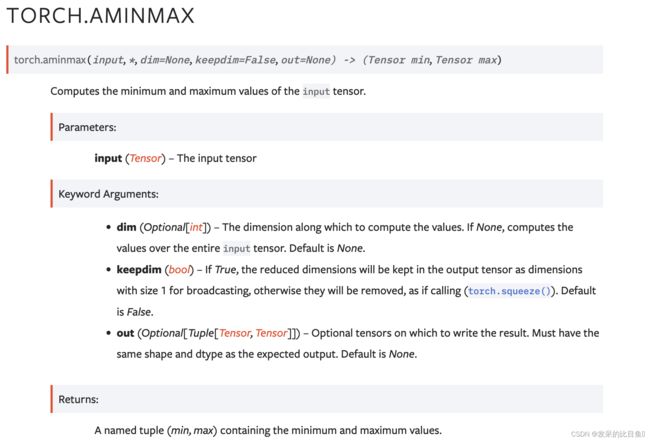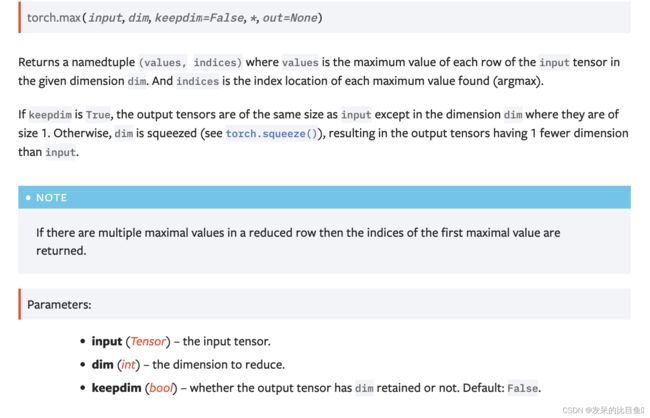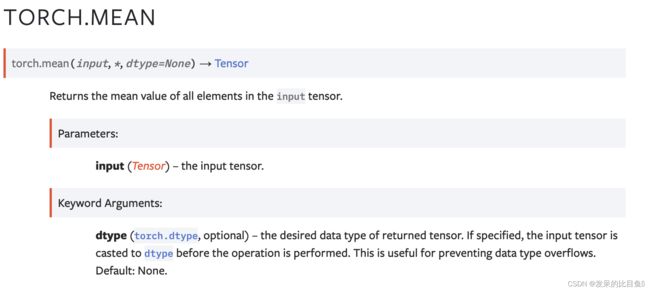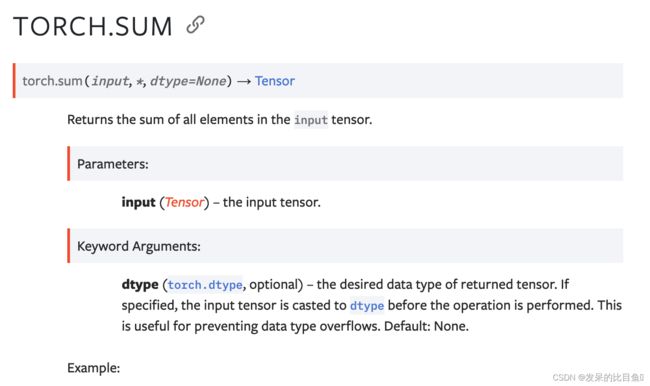小白学Pytorch系列--Torch API (6)
小白学Pytorch系列-- Torch API (6)
Reduction Ops
argmax
>>> a = torch.randn(4, 4)
>>> a
tensor([[ 1.3398, 0.2663, -0.2686, 0.2450],
[-0.7401, -0.8805, -0.3402, -1.1936],
[ 0.4907, -1.3948, -1.0691, -0.3132],
[-1.6092, 0.5419, -0.2993, 0.3195]])
>>> torch.argmax(a)
tensor(0)
argmin
>>> a = torch.randn(4, 4)
>>> a
tensor([[ 0.1139, 0.2254, -0.1381, 0.3687],
[ 1.0100, -1.1975, -0.0102, -0.4732],
[-0.9240, 0.1207, -0.7506, -1.0213],
[ 1.7809, -1.2960, 0.9384, 0.1438]])
>>> torch.argmin(a)
tensor(13)
>>> torch.argmin(a, dim=1)
tensor([ 2, 1, 3, 1])
>>> torch.argmin(a, dim=1, keepdim=True)
tensor([[2],
[1],
[3],
[1]])
amax
>>> a = torch.randn(4, 4)
>>> a
tensor([[ 0.8177, 1.4878, -0.2491, 0.9130],
[-0.7158, 1.1775, 2.0992, 0.4817],
[-0.0053, 0.0164, -1.3738, -0.0507],
[ 1.9700, 1.1106, -1.0318, -1.0816]])
>>> torch.amax(a, 1)
tensor([1.4878, 2.0992, 0.0164, 1.9700])
amin
>>> a = torch.randn(4, 4)
>>> a
tensor([[ 0.6451, -0.4866, 0.2987, -1.3312],
[-0.5744, 1.2980, 1.8397, -0.2713],
[ 0.9128, 0.9214, -1.7268, -0.2995],
[ 0.9023, 0.4853, 0.9075, -1.6165]])
>>> torch.amin(a, 1)
tensor([-1.3312, -0.5744, -1.7268, -1.6165])
aminmax
>>> torch.aminmax(torch.tensor([1, -3, 5]))
torch.return_types.aminmax(
min=tensor(-3),
max=tensor(5))
>>> # aminmax propagates NaNs
>>> torch.aminmax(torch.tensor([1, -3, 5, torch.nan]))
torch.return_types.aminmax(
min=tensor(nan),
max=tensor(nan))
>>> t = torch.arange(10).view(2, 5)
>>> t
tensor([[0, 1, 2, 3, 4],
[5, 6, 7, 8, 9]])
>>> t.aminmax(dim=0, keepdim=True)
torch.return_types.aminmax(
min=tensor([[0, 1, 2, 3, 4]]),
max=tensor([[5, 6, 7, 8, 9]]))
all
>>> a = torch.rand(1, 2).bool()
>>> a
tensor([[False, True]], dtype=torch.bool)
>>> torch.all(a)
tensor(False, dtype=torch.bool)
>>> a = torch.arange(0, 3)
>>> a
tensor([0, 1, 2])
>>> torch.all(a)
tensor(False)
对于给定维度 dim 中的每一行输入,如果该行中的所有元素都评估为 True 则返回 True,否则返回 False。

>>> a = torch.rand(4, 2).bool()
>>> a
tensor([[True, True],
[True, False],
[True, True],
[True, True]], dtype=torch.bool)
>>> torch.all(a, dim=1)
tensor([ True, False, True, True], dtype=torch.bool)
>>> torch.all(a, dim=0)
tensor([ True, False], dtype=torch.bool)
any
>>> a = torch.rand(1, 2).bool()
>>> a
tensor([[False, True]], dtype=torch.bool)
>>> torch.any(a)
tensor(True, dtype=torch.bool)
>>> a = torch.arange(0, 3)
>>> a
tensor([0, 1, 2])
>>> torch.any(a)
tensor(True)
max
>>> a = torch.randn(1, 3)
>>> a
tensor([[ 0.6763, 0.7445, -2.2369]])
>>> torch.max(a)
tensor(0.7445)
>>> a = torch.randn(4, 4)
>>> a
tensor([[-1.2360, -0.2942, -0.1222, 0.8475],
[ 1.1949, -1.1127, -2.2379, -0.6702],
[ 1.5717, -0.9207, 0.1297, -1.8768],
[-0.6172, 1.0036, -0.6060, -0.2432]])
>>> torch.max(a, 1)
torch.return_types.max(values=tensor([0.8475, 1.1949, 1.5717, 1.0036]), indices=tensor([3, 0, 0, 1]))
min
>>> a = torch.randn(1, 3)
>>> a
tensor([[ 0.6750, 1.0857, 1.7197]])
>>> torch.min(a)
tensor(0.6750)
>>> a = torch.randn(4, 4)
>>> a
tensor([[-0.6248, 1.1334, -1.1899, -0.2803],
[-1.4644, -0.2635, -0.3651, 0.6134],
[ 0.2457, 0.0384, 1.0128, 0.7015],
[-0.1153, 2.9849, 2.1458, 0.5788]])
>>> torch.min(a, 1)
torch.return_types.min(values=tensor([-1.1899, -1.4644, 0.0384, -0.1153]), indices=tensor([2, 0, 1, 0]))
dist
返回(输入 - 其他)的 p-范数
>>> x = torch.randn(4)
>>> x
tensor([-1.5393, -0.8675, 0.5916, 1.6321])
>>> y = torch.randn(4)
>>> y
tensor([ 0.0967, -1.0511, 0.6295, 0.8360])
>>> torch.dist(x, y, 3.5)
tensor(1.6727)
>>> torch.dist(x, y, 3)
tensor(1.6973)
>>> torch.dist(x, y, 0)
tensor(4.)
>>> torch.dist(x, y, 1)
tensor(2.6537)
logsumexp
返回给定维度 dim 中输入张量的每一行的指数求和的对数。 计算在数值上是稳定的。

>>> a = torch.randn(3, 3)
>>> torch.logsumexp(a, 1)
tensor([1.4907, 1.0593, 1.5696])
>>> torch.dist(torch.logsumexp(a, 1), torch.log(torch.sum(torch.exp(a), 1)))
tensor(1.6859e-07)
mean
>>> a = torch.randn(1, 3)
>>> a
tensor([[ 0.2294, -0.5481, 1.3288]])
>>> torch.mean(a)
tensor(0.3367)
>>> a = torch.randn(4, 4)
>>> a
tensor([[-0.3841, 0.6320, 0.4254, -0.7384],
[-0.9644, 1.0131, -0.6549, -1.4279],
[-0.2951, -1.3350, -0.7694, 0.5600],
[ 1.0842, -0.9580, 0.3623, 0.2343]])
>>> torch.mean(a, 1)
tensor([-0.0163, -0.5085, -0.4599, 0.1807])
>>> torch.mean(a, 1, True)
tensor([[-0.0163],
[-0.5085],
[-0.4599],
[ 0.1807]])
nanmean
>>> x = torch.tensor([[torch.nan, 1, 2], [1, 2, 3]])
>>> x.mean()
tensor(nan)
>>> x.nanmean()
tensor(1.8000)
>>> x.mean(dim=0)
tensor([ nan, 1.5000, 2.5000])
>>> x.nanmean(dim=0)
tensor([1.0000, 1.5000, 2.5000])
# If all elements in the reduced dimensions are NaN then the result is NaN
>>> torch.tensor([torch.nan]).nanmean()
tensor(nan)
median
>>> a = torch.randn(1, 3)
>>> a
tensor([[ 1.5219, -1.5212, 0.2202]])
>>> torch.median(a)
tensor(0.2202)
>>> a = torch.randn(4, 5)
>>> a
tensor([[ 0.2505, -0.3982, -0.9948, 0.3518, -1.3131],
[ 0.3180, -0.6993, 1.0436, 0.0438, 0.2270],
[-0.2751, 0.7303, 0.2192, 0.3321, 0.2488],
[ 1.0778, -1.9510, 0.7048, 0.4742, -0.7125]])
>>> torch.median(a, 1)
torch.return_types.median(values=tensor([-0.3982, 0.2270, 0.2488, 0.4742]), indices=tensor([1, 4, 4, 3]))
nanmedian
>>> a = torch.tensor([1, float('nan'), 3, 2])
>>> a.median()
tensor(nan)
>>> a.nanmedian()
tensor(2.)
>>> a = torch.tensor([[2, 3, 1], [float('nan'), 1, float('nan')]])
>>> a
tensor([[2., 3., 1.],
[nan, 1., nan]])
>>> a.median(0)
torch.return_types.median(values=tensor([nan, 1., nan]), indices=tensor([1, 1, 1]))
>>> a.nanmedian(0)
torch.return_types.nanmedian(values=tensor([2., 1., 1.]), indices=tensor([0, 1, 0]))
mode
返回一个 namedtuple (values, indices),其中 values 是给定维度 dim 中输入张量的每一行的模式值,即该行中最常出现的值,indices 是找到的每个模式值的索引位置。

norm
返回给定张量的矩阵范数或向量范数。

默认为p=‘fro’,计算矩阵的Frobenius norm (Frobenius 范数),就是矩阵A各项元素的绝对值平方的总和,数学表达式为: ∣ ∣ A ∣ ∣ = ∑ i = 1 m ∑ j = 1 n ∣ a i , j 2 ∣ ||A||=\sqrt{\sum_{i=1}^{m}\sum_{j=1}^n|a_{i,j}^2|} ∣∣A∣∣=∑i=1m∑j=1n∣ai,j2∣
p='nuc’时,是求核范数,核范数是矩阵奇异值的和。(不常用)
常用的是第三种,p为int的形式,则是如下形式:

>>> import torch
>>> a = torch.arange(9, dtype= torch.float) - 4
>>> b = a.reshape((3, 3))
>>> torch.norm(a)
tensor(7.7460)
>>> torch.norm(b)
tensor(7.7460)
>>> torch.norm(a, float('inf'))
tensor(4.)
>>> torch.norm(b, float('inf'))
tensor(4.)
>>> c = torch.tensor([[ 1, 2, 3], [-1, 1, 4]] , dtype=torch.float)
>>> torch.norm(c, dim=0)
tensor([1.4142, 2.2361, 5.0000])
>>> torch.norm(c, dim=1)
tensor([3.7417, 4.2426])
>>> torch.norm(c, p=1, dim=1)
tensor([6., 6.])
>>> d = torch.arange(8, dtype=torch.float).reshape(2, 2, 2)
>>> torch.norm(d, dim=(1, 2))
tensor([ 3.7417, 11.2250])
>>> torch.norm(d[0, :, :]), torch.norm(d[1, :, :])
(tensor(3.7417), tensor(11.2250))
nansum
>>> a = torch.tensor([1., 2., float('nan'), 4.])
>>> torch.nansum(a)
tensor(7.)
>>> torch.nansum(torch.tensor([1., float("nan")]))
1.0
>>> a = torch.tensor([[1, 2], [3., float("nan")]])
>>> torch.nansum(a)
tensor(6.)
>>> torch.nansum(a, dim=0)
tensor([4., 2.])
>>> torch.nansum(a, dim=1)
tensor([3., 3.])
prod
>>> a = torch.randn(1, 3)
>>> a
tensor([[-0.8020, 0.5428, -1.5854]])
>>> torch.prod(a)
tensor(0.6902)
>>> a = torch.randn(4, 2)
>>> a
tensor([[ 0.5261, -0.3837],
[ 1.1857, -0.2498],
[-1.1646, 0.0705],
[ 1.1131, -1.0629]])
>>> torch.prod(a, 1)
tensor([-0.2018, -0.2962, -0.0821, -1.1831])
quantile
沿维度 dim 计算输入张量的每一行的第 q 个分位数。
为了计算分位数,我们将 [0, 1] 中的 q 映射到索引范围 [0, n] 以找到分位数在排序输入中的位置。如果分位数位于排序顺序为索引 i 和 j 的两个数据点 a < b 之间,则根据给定的插值方法计算结果,如下所示:
linear: a + (b - a) * fraction 其中fraction是计算分位数索引的小数部分。
lower: a.
higher: b.
nearest: a or b, 任何哪个索引都更接近计算的分位数索引(以0.5分数为单位)。
midpoint: (a + b) / 2.

>>> a = torch.randn(2, 3)
>>> a
tensor([[ 0.0795, -1.2117, 0.9765],
[ 1.1707, 0.6706, 0.4884]])
>>> q = torch.tensor([0.25, 0.5, 0.75])
>>> torch.quantile(a, q, dim=1, keepdim=True)
tensor([[[-0.5661],
[ 0.5795]],
[[ 0.0795],
[ 0.6706]],
[[ 0.5280],
[ 0.9206]]])
>>> torch.quantile(a, q, dim=1, keepdim=True).shape
torch.Size([3, 2, 1])
>>> a = torch.arange(4.)
>>> a
tensor([0., 1., 2., 3.])
>>> torch.quantile(a, 0.6, interpolation='linear')
tensor(1.8000)
>>> torch.quantile(a, 0.6, interpolation='lower')
tensor(1.)
>>> torch.quantile(a, 0.6, interpolation='higher')
tensor(2.)
>>> torch.quantile(a, 0.6, interpolation='midpoint')
tensor(1.5000)
>>> torch.quantile(a, 0.6, interpolation='nearest')
tensor(2.)
>>> torch.quantile(a, 0.4, interpolation='nearest')
tensor(1.)
nanquantile
这是 torch.quantile() 的变体,它“忽略”NaN 值,计算分位数 q,就好像输入中的 NaN 值不存在一样。如果减少的行中的所有值都是 NaN,那么该减少的分位数将为 NaN。请参阅 torch.quantile() 的文档。

>>> t = torch.tensor([float('nan'), 1, 2])
>>> t.quantile(0.5)
tensor(nan)
>>> t.nanquantile(0.5)
tensor(1.5000)
>>> t = torch.tensor([[float('nan'), float('nan')], [1, 2]])
>>> t
tensor([[nan, nan],
[1., 2.]])
>>> t.nanquantile(0.5, dim=0)
tensor([1., 2.])
>>> t.nanquantile(0.5, dim=1)
tensor([ nan, 1.5000])
std
计算 dim 指定的维度的标准偏差。 dim 可以是单个维度、维度列表或 None 以减少所有维度。

>>> a = torch.tensor(
... [[ 0.2035, 1.2959, 1.8101, -0.4644],
... [ 1.5027, -0.3270, 0.5905, 0.6538],
... [-1.5745, 1.3330, -0.5596, -0.6548],
... [ 0.1264, -0.5080, 1.6420, 0.1992]])
>>> torch.std(a, dim=1, keepdim=True)
tensor([[1.0311],
[0.7477],
[1.2204],
[0.9087]])
std_mean
计算 dim 指定的维度的标准差和平均值。 dim 可以是单个维度、维度列表或 None 以减少所有维度。

>>> a = torch.tensor(
... [[ 0.2035, 1.2959, 1.8101, -0.4644],
... [ 1.5027, -0.3270, 0.5905, 0.6538],
... [-1.5745, 1.3330, -0.5596, -0.6548],
... [ 0.1264, -0.5080, 1.6420, 0.1992]])
>>> torch.std_mean(a, dim=0, keepdim=True)
(tensor([[1.2620, 1.0028, 1.0957, 0.6038]]),
tensor([[ 0.0645, 0.4485, 0.8707, -0.0665]]))
sum
>>> a = torch.randn(1, 3)
>>> a
tensor([[ 0.1133, -0.9567, 0.2958]])
>>> torch.sum(a)
tensor(-0.5475)
unique
>>> output = torch.unique(torch.tensor([1, 3, 2, 3], dtype=torch.long))
>>> output
tensor([1, 2, 3])
>>> output, inverse_indices = torch.unique(
... torch.tensor([1, 3, 2, 3], dtype=torch.long), sorted=True, return_inverse=True)
>>> output
tensor([1, 2, 3])
>>> inverse_indices
tensor([0, 2, 1, 2])
>>> output, inverse_indices = torch.unique(
... torch.tensor([[1, 3], [2, 3]], dtype=torch.long), sorted=True, return_inverse=True)
>>> output
tensor([1, 2, 3])
>>> inverse_indices
tensor([[0, 2],
[1, 2]])
unique_consecutive
从每组连续的等效元素中消除除第一个元素之外的所有元素。

input(Tensor): 输入张量。
return_inverse(bool): 是否也返回输入张量的元素在返回的output张量中的位置的索引。
return_counts(bool): 是否也返回每个值的出现次数。
>>> x = torch.tensor([1, 1, 2, 2, 3, 1, 1, 2])
>>> output = torch.unique_consecutive(x)
>>> output
tensor([1, 2, 3, 1, 2])
>>> output, inverse_indices = torch.unique_consecutive(x, return_inverse=True)
>>> output
tensor([1, 2, 3, 1, 2])
>>> inverse_indices
tensor([0, 0, 1, 1, 2, 3, 3, 4])
>>> output, counts = torch.unique_consecutive(x, return_counts=True)
>>> output
tensor([1, 2, 3, 1, 2])
>>> counts
tensor([2, 2, 1, 2, 1])
var
计算由 dim 指定的维度的方差。 dim 可以是单个维度、维度列表或 None 以减少所有维度。

>>> a = torch.tensor(
... [[ 0.2035, 1.2959, 1.8101, -0.4644],
... [ 1.5027, -0.3270, 0.5905, 0.6538],
... [-1.5745, 1.3330, -0.5596, -0.6548],
... [ 0.1264, -0.5080, 1.6420, 0.1992]])
>>> torch.var(a, dim=1, keepdim=True)
tensor([[1.0631],
[0.5590],
[1.4893],
[0.8258]])
var_mean
计算 dim 指定的维度的方差和均值。 dim 可以是单个维度、维度列表或 None 以减少所有维度。
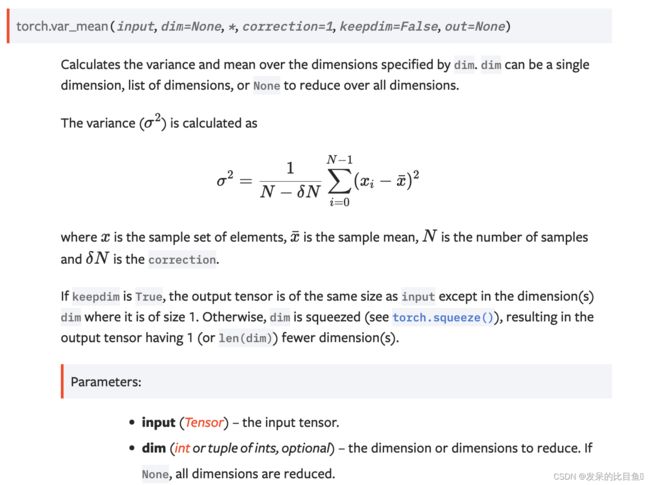
>>> a = torch.tensor(
... [[ 0.2035, 1.2959, 1.8101, -0.4644],
... [ 1.5027, -0.3270, 0.5905, 0.6538],
... [-1.5745, 1.3330, -0.5596, -0.6548],
... [ 0.1264, -0.5080, 1.6420, 0.1992]])
>>> torch.var_mean(a, dim=0, keepdim=True)
(tensor([[1.5926, 1.0056, 1.2005, 0.3646]]),
tensor([[ 0.0645, 0.4485, 0.8707, -0.0665]]))
count_nonzero
沿给定的暗淡计算张量输入中非零值的数量。如果未指定暗淡,则计算张量中的所有非零值。
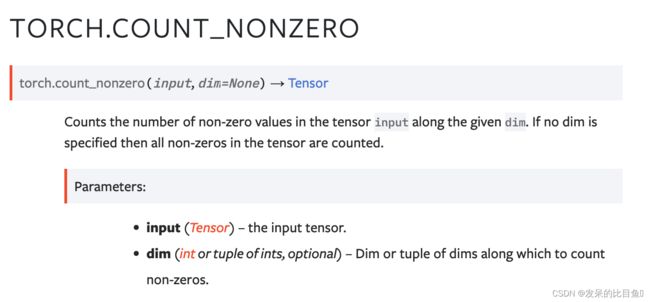
>>> x = torch.zeros(3,3)
>>> x[torch.randn(3,3) > 0.5] = 1
>>> x
tensor([[0., 1., 1.],
[0., 0., 0.],
[0., 0., 1.]])
>>> torch.count_nonzero(x)
tensor(3)
>>> torch.count_nonzero(x, dim=0)
tensor([0, 1, 2])





